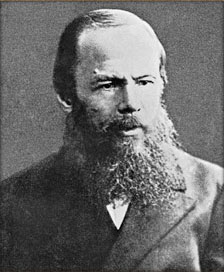While there are many who see ‘The Dream of a Ridiculous Man’ as Dostoevsky’s most convincing portrayal of religious transformation and moral regeneration, it has also been interpreted as a parody, and even as blasphemy. There is, after all, great potential for ambiguity. Is ‘The Dream of a Ridiculous Man’ a fantastic story due to its supernatural content, for example, or the improbability of its message? Is the ridiculous man still ridiculous at the story’s end, or are we meant to understand that he is ridiculous in a different way, or maybe even not ridiculous at all? The story certainly appears to show a path leading from the corrosive powers of Western rationalism to the Slavophile ideal of ‘sobornost’, or spiritual community, except that it is as yet one that is untrod.
Perhaps the main point about the story, as with Dostoevsky’s Writer’s Diary as a whole, and all his mature fiction, is that an element of doubt always remains, but this doubt is the grit that forms the pearl. ‘The Dream of a Ridiculous Man’ succeeds as a work of art precisely because it projects a journey towards an ideal, rather than the ideal itself. Dostoevsky’s thirst for religious faith was genuine, but his often agonising scepticism ensured there was always more than one voice speaking in his writing. Even when he seems to be at his most strident, there was always a dialogue at some level, as becomes clear from the remarkable entry in his A Writer’s Diary about Don Quixote. ‘A Lie is Saved by a Lie’ was written at the time of the Third Battle of Plevna in the Balkans between the Ottoman and Russian Empires in today’s Bulgaria, and published in the issue for September 1877. Its subject is the often heroic necessity for self-deception which all humans must engage in at times order to bridge the painful gap between reality and the ideal.
Amongst the literary heroes who people A Writer’s Diary, Don Quixote is by far the most important. Cherished by Dostoevsky as the greatest exemplar in literature of a ‘positively beautiful’ figure, along with Dickens’ Pickwick and Hugo’s Valjean, Don Quixote was an inspiration behind his own search to create a beautiful character, an artistic equivalent to Christ. It had already produced Prince Myshkin in The Idiot, and would lead finally to Alyosha in The Brothers Karamazov. Don Quixote is beautiful, but he is also ridiculous. In Dostoevsky’s mind social failure was not just a criterion for beauty, but often a pre-requisite for holiness. ‘A Lie is Saved by a Lie’ contains Dostoevsky’s meditations on Cervantes’ masterpiece, as well as an invented scene which is in keeping with Don Quixote’s noble illusion about the beauty of Dulcinea (whose name itself is an allusion to illusion). Perhaps this was Dostoevsky’s best way of saying in so many words that his grand prophesies about Russia, and the imminent arrival of a new era of Christian harmony and brotherly love were a similar delusion in the face of nagging doubts.
Dostoevsky had planned to continue with his Writer’s Diary beyond 1877, but was thwarted by ill health and the demands of writing The Brothers Karamazov. A single issue of A Writer’s Diary appeared for August 1880, and it was dominated by the Pushkin speech he had just given. The unveiling of the first statue of the poet in Russia had been celebrated by four days of public events culminating in Dostoevsky’s speech, which was greeted by a thirty-minute ovation, and an ecstatic outpouring of emotion. Dostoevsky had set out to explore the character and destiny of Russia and the Russian people in his Writer’s Diary, and this speech seemed to sum everything up.
It had been Pushkin with his purely Russian heart, he argued, who had been the first to show how educated Russian society had become tragically detached from its native soil and elevated itself ‘above the People’; only if it embraced ‘the People’s truth’ could it be resurrected. Pushkin was also the first to have created in his literary works ‘artistic types of Russian beauty’ emanating from the ‘People’s truth’, as exemplified by his character Tatyana in Eugene Onegin. And it was Pushkin’s Russian soul, the embodiment of brotherly love, which explained his universality, and concomitant ability to transcend other nations. After the publication of his Pushkin speech, Dostoevsky went back to The Brothers Karamazov. He was by now very sick with pulmonary emphysema, but he had every hope of continuing with the Diary, and was still correcting proofs on the eve of his death. Copies of its single final issue went on sale on 1 February 1881, which was the day of his funeral.
